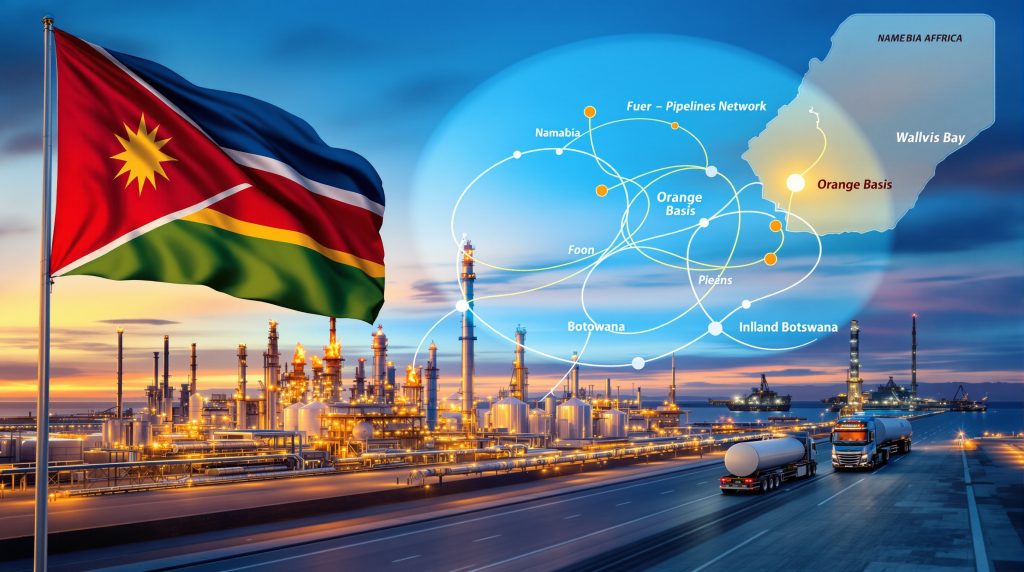Understanding the Namibia-Botswana Joint Oil Refinery Initiative: A Strategic Analysis
The Namibia-Botswana joint oil refinery initiative represents a landmark bilateral energy infrastructure project aimed at transforming Southern Africa's petroleum landscape. This strategic venture, estimated to cost between $3-5 billion, is currently in the feasibility study phase, with both governments evaluating the economic, technical, and environmental aspects of developing shared refining capacity.
The project envisions establishing a regional refining hub that would process crude oil—potentially from Namibia's recent offshore discoveries—into finished petroleum products for domestic consumption and regional export. This ambitious undertaking reflects both countries' determination to reduce dependence on imported fuels and capitalize on emerging upstream opportunities.
Why Are Namibia and Botswana Pursuing This Partnership?
Both nations face significant energy security challenges that this joint venture aims to address. For Namibia, the project represents an opportunity to leverage its coastal position and recent offshore oil discoveries to create value-added industry. For Botswana, as a landlocked nation, the refinery partnership offers a path to greater fuel security and reduced supply vulnerabilities.
The timing aligns with Namibia's emergence as a potential oil producer following major discoveries by TotalEnergies and Shell in the Orange Basin. These findings have generated substantial international interest and created momentum for downstream development planning.
Key strategic benefits include:
- Creating high-skilled employment opportunities in both countries
- Reducing foreign exchange expenditure on imported refined products
- Developing regional technical expertise through knowledge transfer
- Establishing more predictable fuel pricing mechanisms
- Generating additional tax revenue streams for both governments
Proposed Locations and Configurations
Strategic Site Selection Analysis
The feasibility study is examining multiple potential configurations, with two primary locations under consideration:
-
Walvis Bay, Namibia
- Advantages: Existing deep-water port facilities, established logistics infrastructure, proximity to shipping lanes
- Role: Primary refining operations and export terminal
-
Ghanzi, Botswana
- Potential role: Storage and distribution hub rather than primary refining location
- Function: Facilitating inland fuel transport and strategic reserves
The final configuration will likely involve a networked approach, with processing facilities in Namibia connected to storage and distribution infrastructure in Botswana through pipeline or rail transport systems.
Complementary Infrastructure Requirements
Beyond the refinery itself, successful implementation depends on developing:
- Crude oil receiving terminals and storage facilities
- Product pipeline networks connecting production to consumption centers
- Road and rail logistics improvements for regional distribution
- Digital monitoring and control systems for efficient operations
Technical and Economic Challenges
Scale Requirements for Viability
Industry experts highlight several critical thresholds for project viability:
- Minimum economically viable capacity estimated at 100,000 barrels per day (bpd)
- Current combined domestic demand (Namibia ~25,000 bpd plus Botswana's consumption) falls significantly below this threshold
- Need for export markets or regional offtake agreements to achieve necessary scale
This scale challenge represents one of the most significant hurdles for the project, requiring careful market analysis and strategic partnerships with neighboring countries to ensure sufficient demand.
Financial Structuring Considerations
The feasibility study must address complex financial questions:
- Optimal public-private partnership structure to balance control and investment
- Potential involvement of international oil companies or strategic investors
- Risk allocation between government entities and private sector partners
- Access to development finance and export credit agency support
- Currency risk management given the project's multi-national nature
Furthermore, the initiative will require innovative capital raising methods to secure the necessary funding for such a large-scale project.
Technical Configuration Decisions
The technical design must balance multiple competing factors:
- Refinery complexity (simple hydroskimming vs. complex conversion)
- Product slate optimization for regional market needs
- Environmental compliance standards and emissions control
- Operational flexibility to adapt to changing market conditions
- Integration with renewable energy sources for sustainable operations
Regional Energy Dynamics and Integration
Alignment with Southern African Development Community (SADC) Objectives
The refinery initiative supports broader regional integration goals:
- Enhancing energy security across Southern Africa
- Reducing collective import dependence on overseas suppliers
- Creating cross-border infrastructure linkages
- Establishing regional energy trade mechanisms
This alignment with SADC priorities could potentially unlock additional funding support and political backing from regional organizations.
Potential Regional Market Expansion
Beyond domestic markets, the refinery could serve:
- Zambia and Zimbabwe (landlocked neighbors with similar import challenges)
- Angola (potential technical cooperation given their established refining sector)
- South Africa (supplementary capacity for Africa's largest fuel market)
Securing firm offtake agreements with these neighboring countries would be crucial for achieving the necessary economies of scale.
Environmental and Sustainability Factors
Environmental Impact Assessment Requirements
The feasibility study will need to address:
- Water usage requirements in water-stressed regions
- Emissions control technologies and carbon footprint
- Waste management and potential ecological impacts
- Compliance with international environmental standards
- Protection of local biodiversity and ecosystem services
Experts from Global Flow Control have highlighted that environmental considerations will be a central component of the project's feasibility assessment.
Future-Proofing Considerations
Long-term viability requires addressing energy transition factors:
- Flexibility to adapt to changing fuel specifications and environmental regulations
- Potential integration of renewable energy for refinery operations
- Consideration of future demand patterns amid global decarbonization efforts
- Hydrogen production capabilities for emerging clean transportation markets
- Carbon capture potential to mitigate emissions
These sustainability considerations are increasingly important for securing international financing and ensuring the project's long-term relevance in a carbon-constrained world.
Timeline and Implementation Roadmap
Phased Development Approach
Industry experience suggests a multi-stage implementation:
-
Feasibility and Planning Phase (current stage): 12-18 months
- Detailed market analysis
- Technical configuration studies
- Environmental impact assessments
- Financial modeling and partner identification
-
Engineering and Design Phase: 18-24 months
- Front-end engineering design (FEED)
- Financing arrangements finalization
- Regulatory approvals and permitting
- Partner and contractor selection
-
Construction and Commissioning: 36-48 months
- Site preparation and civil works
- Equipment manufacturing and installation
- Utilities and infrastructure development
- Systems integration and testing
-
Operational Ramp-up: 12-24 months
- Gradual capacity utilization increase
- Product certification and market development
- Operational optimization and troubleshooting
- Regional distribution network establishment
This indicates a potential 7-10 year timeline from feasibility to full operational capacity, placing potential completion in the early 2030s assuming smooth progress.
Connection to Namibia's Emerging Oil Sector
Leveraging Recent Exploration Success
The refinery initiative gains momentum from:
- Major discoveries by TotalEnergies and Shell in Namibia's offshore Orange Basin
- Growing international interest in Namibia's petroleum potential
- Opportunity to develop integrated upstream-downstream value chains
The timing of these upstream developments will be critical, as synchronizing domestic crude production with refining capacity would create significant economic advantages. Recent US oil production trends and their global impact will also influence the project's viability.
Alignment with National Development Plans
The project supports both countries' economic diversification strategies:
- Namibia's Vision 2030 and Harambee Prosperity Plan
- Botswana's Economic Diversification Drive and National Development Plan
Both governments view this initiative as a cornerstone of industrial development and energy independence efforts, with potential spillover benefits in petrochemicals, manufacturing, and services sectors.
Key Success Factors for This Initiative
Critical Implementation Elements
For the project to succeed, several factors must align:
- Securing long-term crude supply arrangements
- Establishing guaranteed offtake agreements with regional buyers
- Developing appropriate financing structures
- Ensuring technical expertise and operational capabilities
- Maintaining political alignment between partner countries
According to The Voice of Africa, the success of this initiative will significantly impact both countries' energy independence strategies.
Regional Cooperation Requirements
Successful implementation depends on:
- Harmonized regulatory frameworks between participating nations
- Coordinated infrastructure development planning
- Aligned customs and trade policies to facilitate petroleum product movement
- Shared commitment to project timelines and development milestones
- Joint risk management and crisis response protocols
The project represents a test case for regional cooperation in capital-intensive infrastructure development, with potential lessons for other cross-border initiatives.
Frequently Asked Questions
How will the refinery be financed?
The $3-5 billion project will likely require a combination of government funding, development finance institution support, and private sector investment through various public-private partnership structures. Export credit agencies, African development banks, and strategic industry partners would be crucial funding sources.
When could the refinery become operational?
Based on typical development timelines for major refining projects, and assuming successful feasibility outcomes, the facility could potentially begin operations in the 2030-2032 timeframe. This depends on maintaining project momentum and securing necessary approvals and financing.
What capacity is being considered for the refinery?
While specific capacity targets haven't been publicly confirmed, industry experts suggest a minimum economically viable capacity of approximately 100,000 barrels per day would be necessary. This exceeds the current domestic consumption of both countries, requiring export-oriented operations.
How will crude oil supply be secured?
Initial operations may rely on imported crude, with potential future supply from Namibia's offshore discoveries once they reach production phase. Long-term supply agreements will be essential for project viability, potentially including participation from the upstream operators as strategic partners.
What environmental standards will the refinery follow?
The facility would likely need to meet international environmental standards to attract financing and ensure sustainability, including modern emissions control technology and water management systems. Both countries have committed to responsible development principles in their regulatory frameworks.
How will refined products be transported to landlocked Botswana?
The project would require development of pipeline infrastructure or enhanced rail/road logistics networks to transport finished petroleum products from coastal Namibia to inland markets. This multi-modal distribution system would be integral to the overall project design.
Strategic Outlook and Investment Implications
The Namibia-Botswana refinery project represents a bold vision for regional energy integration, but faces significant challenges in terms of financing, market development, and technical execution. Success will depend on maintaining strong political support, securing reliable crude supplies, and developing sufficient regional demand to achieve economic scale.
For investors, the project offers potential investment opportunities analysis across construction, operations, logistics, and associated services. However, careful risk assessment would be essential given the project's complexity and multi-year development timeline.
The initiative also reflects a broader trend across Africa toward developing integrated energy value chains and reducing dependence on imported refined products—a strategic priority that resonates across the continent as nations seek greater economic self-determination and energy security.
Investors should remain vigilant for potential investment risk signals and monitor for possible oil price crash insights that could impact the Namibia-Botswana joint oil refinery feasibility study and its long-term economic viability.
Looking for Early Insights on Emerging Resource Opportunities?
Discover significant mineral announcements before the wider market with Discovery Alert's proprietary Discovery IQ model, delivering real-time notifications on ASX discoveries that could mirror the growth potential of regional energy projects like the Namibia-Botswana refinery initiative. Visit Discovery Alert's discoveries page to understand how early identification of resource opportunities can lead to exceptional investment returns.




